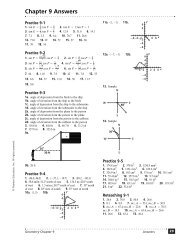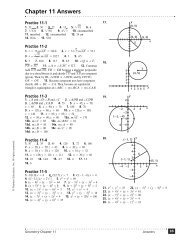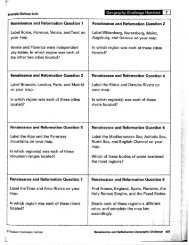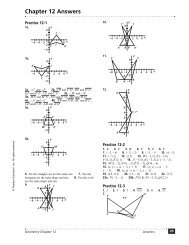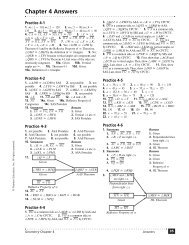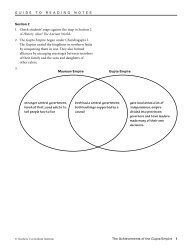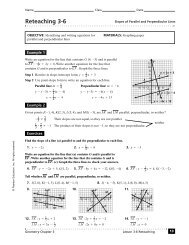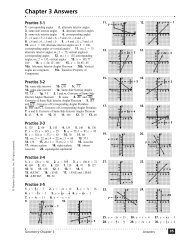Chapter 12 Sequences; Induction; the Binomial Theorem
Chapter 12 Sequences; Induction; the Binomial Theorem
Chapter 12 Sequences; Induction; the Binomial Theorem
Create successful ePaper yourself
Turn your PDF publications into a flip-book with our unique Google optimized e-Paper software.
Section <strong>12</strong>.2: Arithmetic <strong>Sequences</strong><br />
Section <strong>12</strong>.2<br />
1. arithmetic<br />
2. False; <strong>the</strong> sum of <strong>the</strong> first and last terms equals<br />
twice <strong>the</strong> sum of all <strong>the</strong> terms divided by <strong>the</strong><br />
number of terms.<br />
3. d = sn<br />
−sn−1<br />
= ( n+ 4) −( n− 1+ 4) = ( n+ 4) − ( n+<br />
3)<br />
= n+ 4−n− 3=<br />
1<br />
The difference between consecutive terms is<br />
constant, <strong>the</strong>refore <strong>the</strong> sequence is arithmetic.<br />
s1 = 1+ 4= 5, s2 = 2+ 4= 6, s3<br />
= 3+ 4=<br />
7,<br />
s = 4+ 4=<br />
8<br />
4.<br />
5.<br />
6.<br />
4<br />
d = s −s<br />
n<br />
n−1<br />
( ) ( )<br />
= ( n−5) −( n−1− 5) = n−5 − n−6<br />
= n−5− n+ 6=<br />
1<br />
The difference between consecutive terms is<br />
constant, <strong>the</strong>refore <strong>the</strong> sequence is arithmetic.<br />
s1 = 1− 5 =− 4, s2 = 2 − 5 =− 3, s3<br />
= 3 − 5 =−2,<br />
s = 4− 5= −1<br />
4<br />
d = an<br />
−an−1<br />
= ( 2n−5 ) −(2( n−1) −5)<br />
= ( 2n−5) −( 2n−2−5)<br />
= 2n−5− 2n+ 7 = 2<br />
The difference between consecutive terms is<br />
constant, <strong>the</strong>refore <strong>the</strong> sequence is arithmetic.<br />
a1 = 21 ⋅ − 5= − 3, a2<br />
= 22 ⋅ − 5= −1,<br />
a = 23 ⋅ − 5= 1, a = 24 ⋅ − 5=<br />
3<br />
3 4<br />
d = bn<br />
−bn−1<br />
= ( 3n+ 1 ) −(3( n− 1) + 1)<br />
= ( 3n+ 1) −( 3n− 3+<br />
1)<br />
= 3n+ 1− 3n+ 2=<br />
3<br />
The difference between consecutive terms is<br />
constant, <strong>the</strong>refore <strong>the</strong> sequence is arithmetic.<br />
b1 = 31 ⋅ + 1= 4, b2<br />
= 32 ⋅ + 1=<br />
7,<br />
b = 3⋅ 3+ 1= 10, b = 3⋅ 4+ 1=<br />
13<br />
3 4<br />
7.<br />
8.<br />
d = c − c<br />
n<br />
n−1<br />
( n)<br />
n<br />
( 6 2n) ( 6 2n<br />
2)<br />
= 6−2 −(6−2( −1))<br />
= − − − +<br />
= 6−2n− 6+ 2n− 2=−2<br />
The difference between consecutive terms is<br />
constant, <strong>the</strong>refore <strong>the</strong> sequence is arithmetic.<br />
c = 6−2⋅ 1= 4, c = 6−2⋅ 2=<br />
2,<br />
c<br />
1 2<br />
= 6−2⋅ 3= 0, c = 6−2⋅ 4=−2<br />
3 4<br />
d = d − d<br />
n<br />
n−1<br />
( n)<br />
n<br />
( 4 2n) ( 4 2n<br />
2)<br />
= 4−2 −(4−2( −1))<br />
= − − − +<br />
= 4−2n− 4+ 2n− 2=−2<br />
The difference between consecutive terms is<br />
constant, <strong>the</strong>refore <strong>the</strong> sequence is arithmetic.<br />
d = 4−2⋅ 1= 2, d = 4−2⋅ 2=<br />
0,<br />
d<br />
1 2<br />
= 4−2⋅ 3= − 2, d = 4−2⋅ 4= −4<br />
3 4<br />
9. d = tn<br />
− tn−1<br />
⎛1 1 ⎞ ⎛1 1 ⎞<br />
= ⎜ − n⎟−⎜ − ( n−<br />
1) ⎟<br />
⎝2 3 ⎠ ⎝2 3 ⎠<br />
⎛1 1 ⎞ ⎛1 1 1⎞<br />
= ⎜ − n⎟−⎜ − n+<br />
⎟<br />
⎝2 3 ⎠ ⎝2 3 3⎠<br />
1 1 1 1 1 1<br />
= − n− + n− = −<br />
2 3 2 3 3 3<br />
The difference between consecutive terms is<br />
constant, <strong>the</strong>refore <strong>the</strong> sequence is arithmetic.<br />
1 1 1 1 1 1<br />
t1 = − ⋅ 1 = , t2<br />
= − ⋅ 2 =− ,<br />
2 3 6 2 3 6<br />
1 1 1 1 1 5<br />
t3 = − ⋅ 3 =− , t4<br />
= − ⋅ 4=−<br />
2 3 2 2 3 6<br />
10. d = tn<br />
− tn−1<br />
⎛2 1 ⎞ ⎛2 1 ⎞<br />
= ⎜ + n⎟− ⎜ + ( n−<br />
1) ⎟<br />
⎝3 4 ⎠ ⎝3 4 ⎠<br />
⎛2 1 ⎞ ⎛2 1 1⎞<br />
= ⎜ + n⎟− ⎜ + n−<br />
⎟<br />
⎝3 4 ⎠ ⎝3 4 4⎠<br />
2 1 2 1 1 1<br />
= + n− − n+ =<br />
3 4 3 4 4 4<br />
The difference between consecutive terms is<br />
constant, <strong>the</strong>refore <strong>the</strong> sequence is arithmetic.<br />
2 1 11 2 1 7<br />
t1 = + ⋅ 1 = , t2<br />
= + ⋅ 2 = ,<br />
3 4 <strong>12</strong> 3 4 6<br />
2 1 17 2 1 5<br />
t3 = + ⋅ 3 = , t4<br />
= + ⋅ 4=<br />
3 4 <strong>12</strong> 3 4 3<br />
<strong>12</strong>47<br />
© 2009 Pearson Education, Inc., Upper Saddle River, NJ. All rights reserved. This material is protected under all copyright laws as <strong>the</strong>y currently<br />
exist. No portion of this material may be reproduced, in any form or by any means, without permission in writing from <strong>the</strong> publisher.





